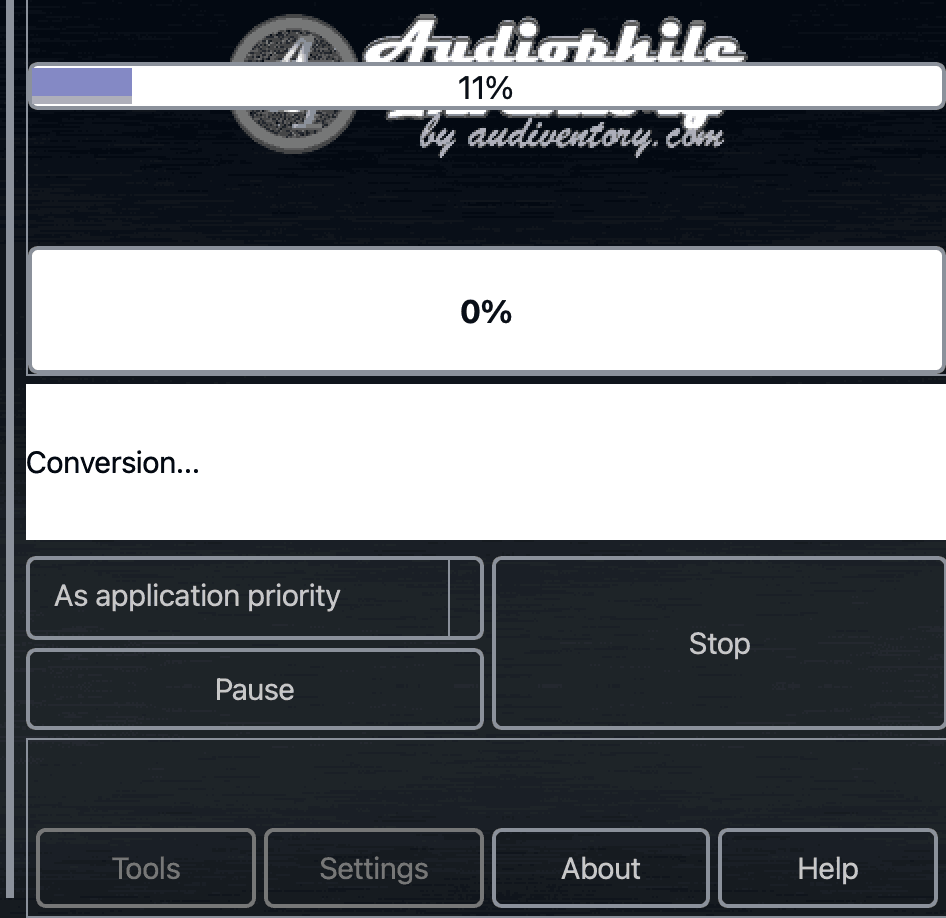![How to Improve Audio Conversion Performance [AuI ConverteR]](jpg/improve-performance-720.jpg)

If you buy "AuI ConverteR PROduce-RD" (2023/12.x version) from 24 August 2023 to 24 October 2023, you will get free update to version 2024 (13.x) after its release.
When AuI ConverteR software converts audio files, it performs many kinds of processing: audio and others. Here we review how to try to save time for the audio file conversion.
AuI ConverteR is intended for work with its lowest distortion level. And audio file conversion in high quality consumes huge resources for precise math. And the developers can't reduce the time for lower quality. So, even powerful computers are not so fast for these tasks. But what we can do?
Back to top
Sound quality
General description
Computer configuration, operating system doesn't impact to sound quality.
Resampling filter choice in AuI ConverteR setting may impact to performance. Different combinations of input and output sampling rates requires different computing resources. And higher sampling rates are processed longer, as rule.
Higher audio-processing quality requires more computing resources and time, respectively.
In AuI ConverteR's design, balance is shifted to higher sound quality side. It allows achieving of processing quality close to theoretical limits.
Recommendations
- Minimum phase filters work slower than linear ones.
- G5 filters are most slow than other ones. And G5 filters may be recommended for professional using rather.
Read what is minimum and linear phase filters...
Back to top
Multi-CPU parallel processing
A modern priocessor consists of several cores. Computers can contain several CPU (central processor unit). Each of cores is capable to process separate task. If go into detail, operating systems distribute all performed tasks between the cores. And core can not be fully given to user level application in common case.
So, we can use parallel processing to save conversion time.
What about parallel processing of a single music file?
The file consists of one or several channels. Digital processing of the audio channel content is provided sample portion by the portion.
We can't process the portions in parallel. Because next portion requires data for the previous-portion calculations.
Parallel processing of different channels requires synchronizing channels with sample precision when write to file. However, the synchronization spends visible time, that may be used more productively.
Read about multi-CPU...
Back to top
Application priority
There is way to ask an operationg system about desirable ptiority for an application.
However, the operating system distributes computing resources by own algorithms.
"Time critical" priority of an application can cause slow work other applications.
Application priority is set into a task manager of operating system.
Inside a applications, can be performed several processes (threads). Each thread can be placed at separate CPU core. Thread priority may be set from AuI ConverteR. However, it is not mandatory setting for operating system. It will prioritize threads according the system algorihms.
In AuI ConverteR's main window, when conversion is started, you can set priority about Stop button.
In the Settings > Misc > use Processing priority list to set default priority.
"Time critical" priority may reduce other applications' performance.
Read also...
Processing pause
Conversion priority and Pause button work for re-sampling stage only.
When Start button pushed, appear Priority list and Pause/Continue button.

Example:
When AuI ConverteR turned to pause mode during ISO extracting, the extracting will continued to resampling stage and stop there. After pushing Continue button (at place of Pause button) resampling continued. Stop button interrupt conversion. Next pushing to Start button launch converting from first file.
Back to top
CPU frequency, cache size
CPU and RAM frequency, cache size, inner architecture are most important for audio format conversion speed. Higher is better.
In instance, Mac computers with M1 (Silicon) processors may give better performance than Intel configurations.
AuI ConverteR version 10.x works via Rosetta. In the future versions, M1 achitecture (arm64) will be supported directly (universal binaries). We expect more performance for M1.
Back to top
RAM size (computer memory)
RAM size is not significant for processing audio signal in resampling or DSD conversion. However, AuI ConverteR scan metadata from audio files, added in source file list, and save it into the RAM-memory. Metadata may contains artworks.
In instance, if an artwork has 330 kbytes size, 10 000 files consumes about 3 Gbytes of a computer RAM.
To prevent RAM overflow, when the scanned artwork matadata cache into RAM is exceed set threshould, AuI ConverteR is caching the metadata into hard disk.
The threshouls is set into Settings > Misc > Maximum artwork RAM cache.
All text matadata are saved into RAM.
Back to top
Hard disk
Hard disk speed may some improve conversion performance. However, it is not so significant for lower sampling rates, especially.
However, it may some improve artwork metadata caching speed (reduce metadata scanning time).
SSD is recommended generally.
Hard disk size should provides reserve for cache audio files when converting is performed.
As example, SACD ISO extracting requires space up to several time more source .iso file.
In general, it's recommended 20 ... 200 GB of free space at HDD partition with temporary files.
Back to top


